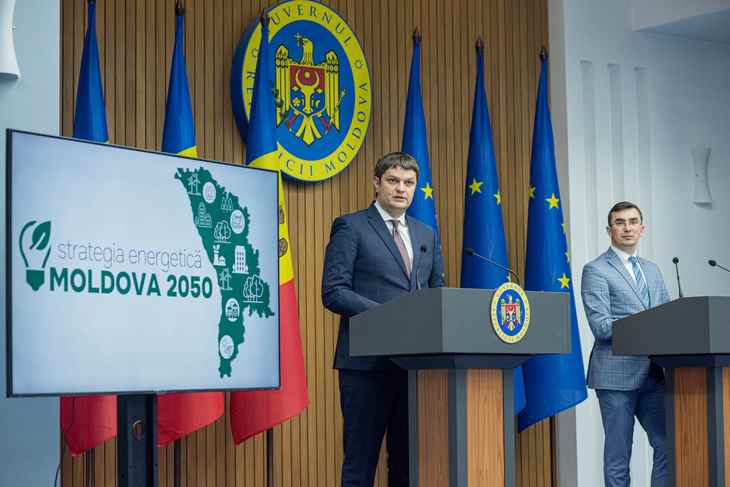The Deputy Prime Minister of the Republic of Moldova Andrei Spînu, together with the State Secretary for Energy, Constantin Boroșan, presented the concept of the Energy Strategy of the Republic of Moldova 2050 (the file in Romanian). The energy strategy will be structured in 5 chapters, and the first one will refer to increasing energy security.
Among the priorities are mentioned:
- Construction of a power plant, based on flexible technology with internal combustion engines, with a capacity between 80 and 100 MW, to increase the balancing / balancing capabilities of the power system and the integration of a greater capacity of renewable energy sources;
- Construction of a cogeneration power plant, based on flexible technology, based on combined cycle steam gas, with an electrical efficiency of over 55% and a capacity of at least 250 MW;
- Increasing energy interconnectivity with neighboring countries, by completing the construction of the 400 kV Vulcanesti-Chisinau overhead power line;
- Construction of a new overhead power line between Moldova and Romania LEA 400 kV Bălți-Suceava;
- Analysis of the feasibility of the interconnection projects between Moldova and Romania LEA Vulcănești – Smârdan and between Moldova and Ukraine, the second circuit of LEA Bălți – CHE Dnestrovsk;
- Consolidation of the national natural gas transportation system and facilitation of gas transit to storage facilities in Ukraine;
- Development of the storage infrastructure for reserve fuels for power plants;
- Creation of strategic / security stocks of natural gas;
- Creation of strategic / security stocks of petroleum products
The development of competitive energy markets and regional integration constitute the second chapter of the energy strategy of the Republic of Moldova, with the following directions to follow:
- Completion of the process of separation and independence (unbundling) of the Natural Gas Transmission System Operator to ensure guaranteed non-discriminatory access of alternative suppliers to the transmission network
- Designation of a commercial operator of the electricity market;
- Launch of competitive organized day-ahead and intraday markets in the power sector;
- Use of platforms developed by ENTSO-E for the exchange of balancing and system services.
To promote energy efficiency (chapter 3), interventions such as take into consideration:
- Energy rehabilitation of approximately 400,000 square meters of residential buildings per year;
- Energy rehabilitation of approximately 170,000 square meters of public buildings per year;
- Electrification of the heating sector by phasing out natural gas boilers, heating devices with resistive radiators, as well as inefficient biomass stoves and replacing them with heat pumps;
- Implementation of smart metering systems;
- Modernization of centralized thermal energy supply systems, including by promoting individual thermal points and the horizontal distribution of the thermal agent;
- Creating initiatives to support the increase in the number of electric cars up to around 500 thousand in 2030;
- Creating initiatives to support the transition of urban public transport or freight transport to hybrid or electric vehicles;
- Implementation of mandatory energy audits for large companies and application of energy management standards.
Chapter four focuses on Promoting sustainability, renewable energy and low emissions, with proposed measures such as:
- Construction of photovoltaic parks with a total power of about 200 MW;
- Construction of wind parks with a total power of about 250 MW;
- Construction of power plants based on biogas and biomass with a total power of 65 MW;
- Construction of power plants for the energy recovery of waste with a total power of 20 MW;
- Construction of electricity storage systems with batteries with a capacity of 85 MW until 2035;
- Sustainable development of the biomass sector by promoting the establishment of energy plant plantations;
- Transposition and implementation of the provisions on renewable energy communities;
- Introducing net billing and facilitating the connection of industrial power plants that produce for their own consumption.
The last chapter refers to Consumer Protection and the reduction of energy poverty, the objective for which the plan is
- To reduce the impact of energy crises and the energy burden;
- To protect vulnerable consumers through appropriate social aids, such as compensation for the consumption of natural gas, heat and electricity. Establishing public programs for thermal insulation of buildings for communities affected by energy poverty, etc.
The proposals on the Energy Strategy Concept were collected during the 5 workshops / thematic workshops organized between May 27, 2022 and June 24, 2022 with the participation of interested parties and experts in the field of energy, within the “Moldova Energy Security Activity” Project implemented by USAID Moldova for the support granted in order to promote the Energy Strategy of the Republic of Moldova until the year 2050.
